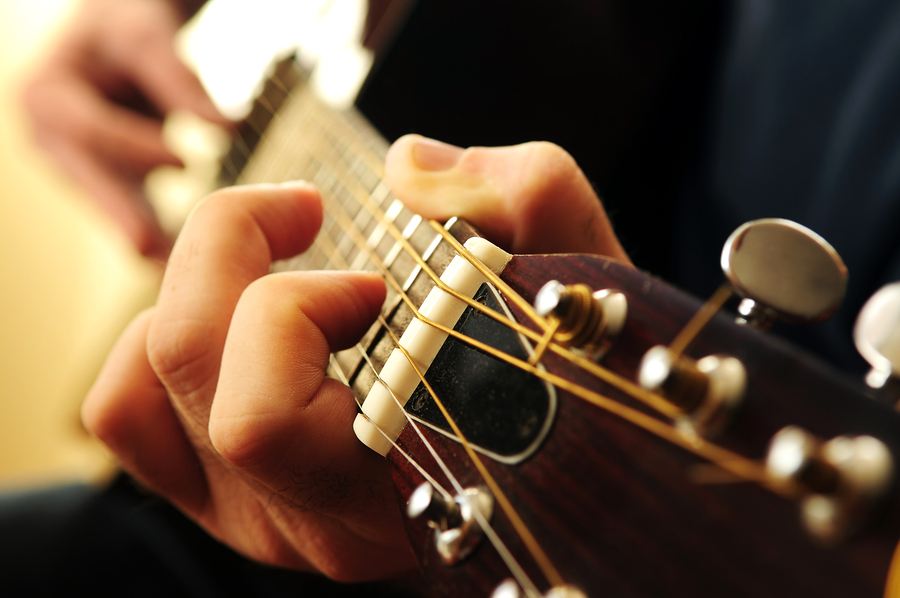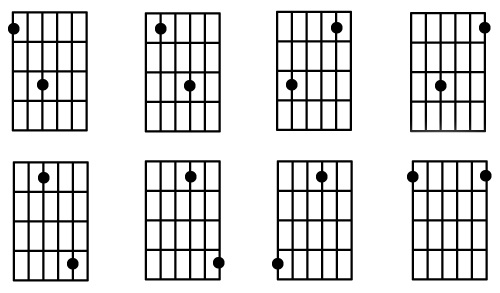May 15, 2019 by Klaus Crow
Photo by Bigstock photo
 Most intermediate guitar players can find the notes across the neck on the 6th (low E) and 5th string (A). This is essential for learning barre chords, soloing and a lot of other stuff. If you don’t know the notes on the 6th and 5th string yet check out Learn The Guitar Fingerboard Thoroughly in 16 Days
Most intermediate guitar players can find the notes across the neck on the 6th (low E) and 5th string (A). This is essential for learning barre chords, soloing and a lot of other stuff. If you don’t know the notes on the 6th and 5th string yet check out Learn The Guitar Fingerboard Thoroughly in 16 Days
Once you’ve memorized the notes on the 6th and 5th string you can easily find any other note on the guitar. You can do this with octaves. An octave is in essence an interval whose higher note has a frequency of vibration twice that of its lower note.
If you think in notes, an octave is an interval with the distance of 12 half steps (12 frets) in the chromatic scale. For example, if you’re on the 1st fret, 6th string (F note) and go up 12 frets, which will take you to the 13th fret, you will also hit on an F note only one octave higher. You can apply this to every fret and every string.
If you think scale wise, an octave is the distance of 7 notes in the diatonic scale. So if you start on the first note of a scale and you go up 7 notes in the scale you arrive on the 8th note which is the octave.
Each of the diagrams below shows an octave, that means the notes share the same name except one note is higher or lower than the other. Now we can find the name any note or octave on the entire neck.
Let’s take a closer look
DIAGRAMS 1 – 8:

Diagram 1
For example if you want to find the name of the note on 3rd fret, 4th string (D-string) then take your finger from this note and go down 2 strings and then 2 frets back and you have the same note (only one octave lower). Now you’re on the 1st fret, 6th string and this is an F note. So the note on the 3rd fret, 4th string is also an F note. You can do this any where on the string, just use the same shape of the first diagram.
Diagram 2
Let’s say I want to find the name of the note on the 7th fret, 3rd string, (G-string) again I go 2 strings down and 2 frets back and I have arrived on the 5th fret, 5th string. This is a D note, so the note on the 7th fret, 3rd string is the same note (only an octave higher), but it’s the same note name.
Diagram 3
To find the note name of any note on the 2nd string (B-string), just pick a random note on the 2nd string and then go 2 frets up and 3 strings down and you’ve arrived on the 5th-string of which you know the notes. For example: 5th fret, 2nd string? Go up 2 frets and down 3 strings and you’re on the 7th fret, 5th string which is an E note.
Diagram 4
Diagram 4 has the same shape as diagram 3. Pick a note on the 1st string (high E-string). Let’s say 3rd fret which is a G-note. You already know this because the notes on the 1st string are the same as the notes on the 6-string. 3rd fret, 1st string from this note go up 2 frets and down 3 strings and you’re on the 5th fret, 4th string which is also a G-note.
And obviously we can also do this the other way around. Let’s say you start on the 5th fret, 4th string, now go 2 frets down and 3 strings up to find the octave and you’ve arrived on the 3rd fret, 1st string. Both G notes.
Diagram 5
Want to find the octave of any note on the 4th string (D-string)? Go 3 frets and 2 strings up. For example: Let’s pick the 3rd fret on the 4th string. To find the note name first use the octave shape of diagram 1, go 2 strings down and 2 frets back and you arrive on the F note. So the note on the 3rd fret, 4th strings is also an F note. Now use diagram 5, go 3 frets up and 2 strings up and you’re on the 6th fret, 2nd string, another F note an octave higher.
Diagram 6
To find the note name of any note on the 3rd string (G-string) just pick a random note on the 3rd string and then go 3 frets and 2 strings up and you’ve arrived on the 1st-string of which you know all the note names (they are the same as the notes on the 6th string). For example: If you’re on 5th fret, 3rd string. Go 3 frets up and 2 strings up and you’re on the 8th fret, 1st string which is a C note.
Diagram 7
Another way to find the note name of any note on the 3rd string (G-string) is to go 3 frets up and 3 strings down. Now you land on the 6th string (low E). So again, if you’re on 5th fret, 3rd string and you go 3 frets up and 3 strings down you’re arrive on the 8th fret, 6th string which is also a C note.
Diagram 8
As mentioned before all the notes on the 6th string (low E-string) are the same as the notes on the 1st string (high E-string). So if you’re on 5th fret 6th string which happens to be an A note then the note on the 5th fret 1st string is also an A note, only two octaves higher.
Assignment: Memorize all eight octave shapes to easily move from one octave to the next.
Join the Guitarhabits facebook page to keep up with the latest posts, guitar lesson videos, tips, tricks and other news about Guitarhabits.

Hi Klaus sir,
I had already learned the “Learn The Guitar Fingerboard Thoroughly in 16 Days”. Following this exercise is much easier to find the notes in the guitar.By knowing notes in 5&6 string it is easier to determine other notes.Thanks for sharing.
Hi Prasana,
The two posts complement each other perfectly. I think, the diagrams in this post are a little easier to read.
Best regards,
Klaus Crow
Glad you shared this Klaus. I naturally started doing it when I reached that level. I never learned notes but I would come up with a rhythm and then need to make a lead piece for it. After much head bashing I figured out the octave trick that you explained above. I only hope that new guitarists find this article so they don’t have to go through all that frustration like I did ;)
a great lesson the shaker RBL thanks for your time